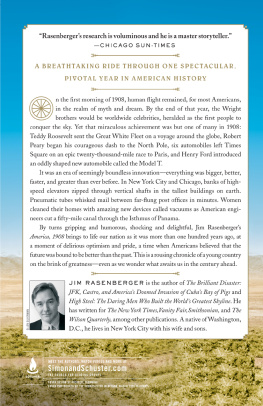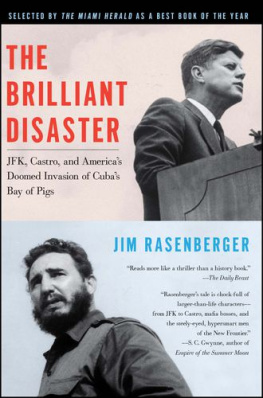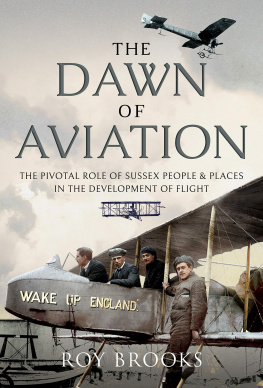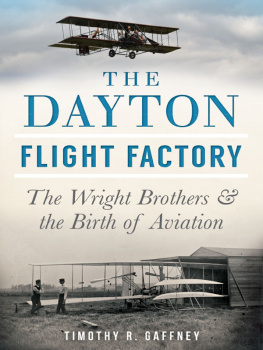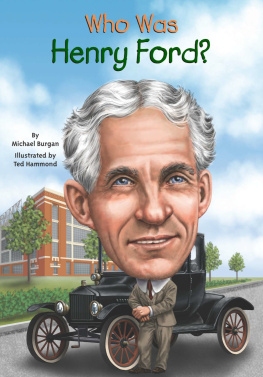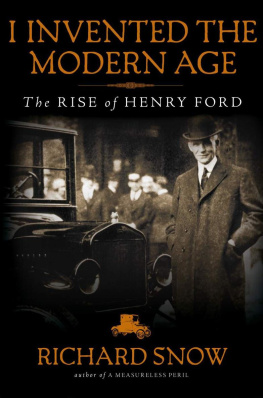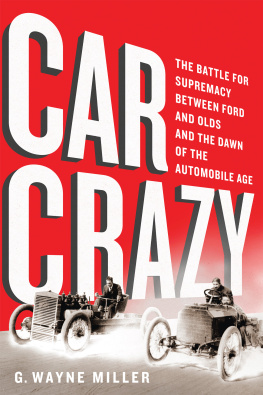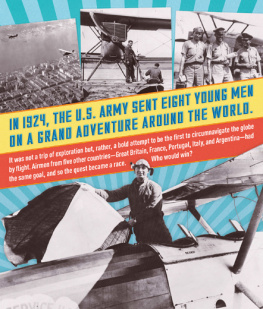Praise for America, 1908
Rasenberger renders 1908 as a series of snapshots, and his camera never blinks.
Publishers Weekly
Jim Rasenberger has found the perfect aperture through which to view the explosion of modernity. 1908 was indeed a big bang of a year, a year full of hope and promise but also one which presented our world with a Pandoras box of unforeseen perils. Readers will loveand historians will envythe graceful simplicity of Rasenbergers singular prism. America, 1908 effortlessly transports us back to the future, to a distant time and place that seems oddly familiar.
Hampton Sides, author of Blood and Thunder and Ghost Soldiers
This is a wonderful surprise of a booka time machine back to the year when the American Century got going full tilt. Jim Rasenberger writes in a voice as winning as Theodore Roosevelts smile and pilots his machine with a sure-handedness that would have impressed the Wright brothers. When you finish America, 1908, you will swear you were there.
Patricia OToole, author of When Trumpets Call:
Theodore Roosevelt after the White House
An exhilarating panorama of the United States as it was a century ago. The cast of characters here, from Teddy Roosevelt to Fred Merkle (the luckless batter whose mistake lost the New York Giants a still-legendary pennant race), is unforgettable. And the America that shows itself in this masterful narrative constantly reveals links to America today.
Mark Caldwell, author of New York Night:
The Mystique and Its History
America, 1908 is an intricate time machine with moving parts that mesh like a fine old gold watch, transporting the reader to a time extraordinarily like and yet unlike our own. Rasenberger, a master of detail, gives us a superb rendition of an important and fascinating American moment.
James Tobin, author of To Conquer the Air:
The Wright Brothers and the Great Race for Flight
Praise for High Steel
A first-rate look at the majesty and danger of building modern cities... sympathetic... a comprehensive celebration of [the] men who for more than a century have willingly accepted the risks it took to put the American skyscraper on the map.
Kirkus Reviews (starred review)
Tantalizing... Rasenbergers muscular portrait deserves an outsize audience.
Booklist
Reveals as much about the human spirit as about technological progress... Rasenbergers compelling book makes us look at the familiar story of the growth of New York from a new point of viewthat of the men who actually built it.
The Wall Street Journal
Admirable... Rasenberger tells his tale uncommonly well.
Jonathan Yardley, The Washington Post Book World
Rasenberger writes about the wow of the beam, the feeling an iron-worker has while walking and sometimes running on a piece of steel... the reader shares that wow feeling throughout this riveting historical work.
Chicago Sun-Times
Mr. Rasenbergers sharp eye... his sympathetic imagination, and his graceful prose make for an engaging read.... Beautifully written.
The New York Sun
Fascinating.
New York magazine
A spirited book about people engaged in some of the most dangerous and nerve-wracking work on the planet... Rasenberger has an ear for these mens stories and puts a human faceboth heroic and tragicon what are very often inhuman places.
The News & Observer
One of THE BEST BOOKS OF 2004 (Featuring Twenty Terrific Titles That We Fear You Missed).
Kirkus Reviews (year-end special)

A LSO BY J IM R ASENBERGER
High Steel: The Daring Men Who Built
the Worlds Greatest Skyline


SCRIBNER
A Division of Simon & Schuster, Inc.
1230 Avenue of the Americas
New York, NY 10020
www.SimonandSchuster.com
Copyright 2007 by Jim Rasenberger
All rights reserved, including the right to reproduce this book or portions thereof in any form whatsoever. For information, address Scribner Subsidiary Rights Department, 1230 Avenue of the Americas, New York, NY 10020.
First Scribner trade paperback edition June 2011
SCRIBNER and design are registered trademarks of The Gale Group, Inc., used under license by Simon & Schuster, Inc., the publisher of this work.
The Simon & Schuster Speakers Bureau can bring authors to your live event. For more information or to book an event, contact the Simon & Schuster Speakers Bureau at 1-866-248-3049 or visit our website at www.simonspeakers.com.
DESIGNED BY ERICH HOBBING
Text set in Adobe Caslon
Manufactured in the United States of America
1 3 5 7 9 10 8 6 4 2
Library of Congress Control Number: 2007025885
ISBN 978-0-7432-8077-8
ISBN 978-0-7432-8078-5
eISBN 978-1-4165-5262-8
For Ann
PROLOGUE
Leap Year
A ny book that hopes to convince its readers that a particular year of Americas past was pivotalthat it was The Year That Changed Everything, or The Year That Made America, or some such grandiose claimis suspect at the outset. History does not fit neatly into the annual cycles of the Gregorian calendar. A year is not a historical category, its a cosmological event: a single revolution of the earth around the sun; three hundred and sixty-five spins on its polar axis; or, in the case of 1908, a leap year, three hundred and sixty-six.
With that in mind, here is a more modest claim: 1908, by whatever quirk of history or cosmology, was one hell of a ride around the sun.
It began at midnight on January 1, 1908, when a seven-hundred-pound electric ball fell from the flagpole atop the New York Times buildingthe first-ever ball-drop in Times Squareand ended December 31, 1908, with a two-and-a-half-hour flight by Wilbur Wright, the longest ever made in an airplane. In the days between, the Great White Fleet sailed around the world, Admiral Robert Peary began his conquest of the North Pole, Dr. Frederick Cook reached the North Pole (or claimed to), six automobiles set out on a twenty-thousand-mile race from New York City to Paris (via the frozen Bering Strait), and the New York Giants battled the Chicago Cubs in one of the strangest and most thrilling seasons in the history of baseball.
Most dramatically, in the spring of 1908, then again in late summer, the Wright brothers proved to the world theyd mastered the skies. The Wrights had first flown at Kitty Hawk in 1903, but not until August and September of 1908, during a series of simultaneous aerial demonstrations at Fort Myer, Virginia (Orville), and Le Mans, France (Wilbur), did America and the rest of the world truly grasp what they had accomplished. That September was, quite simply, one of the most astonishing months in modern history.
A few weeks after Orville Wrights flight trials ended spectacularly (and tragically) at Fort Myer, an automobile called the Model T went into production at Henry Fords Piquette Avenue plant in Detroit, Michigan. The Model T very soon transformed not only the automotive industry but, in turn, almost every aspect of how Americans lived and worked. Fords automobile arrived more quietly than the Wrights airplane, but its impact on the daily lives of most Americans was more immediate and far greater.

